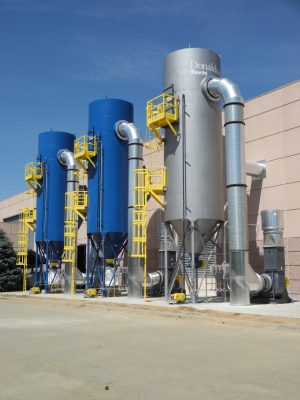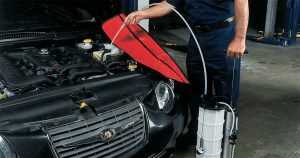
Industrial Dust Collector – Purify and Filter Hazardous Matter and Gas Fumes
Dust collectors are air control systems used in warehouses, plants and factories to purify and filter hazardous matter and gas fumes. These machines are vital for facilities that rely on pure air to ensure safety and maximize productivity.
A dust collection system consists of ductwork that forces air through a filter, collecting contaminants. This material is funneled into a receptacle—such as a box, bag or drum—for future disposal.
Pulse Jet Collectors
Pulse jet collectors feature a series of short bursts of compressed air that strike the bags to free dust cake from the filter. They’re often used for large, combustible dusts or in areas where the accumulation of finer, lighter-weight particles can clog bags and reduce efficiency. They’re similar to shaker style systems in that they both house bag filters in skeletal frame housings, and they both use a blow-off method to clean the bags.
The system’s sensors detect when the bags have collected enough dust to block the bag’s filtration pores and activate a cycle of rapid high-pressure air that sends a blast of air against the filter. This breaks apart the layer of fine dust clinging to the surface and discharges it into a hopper for disposal or reuse. The duration of each pulse and the interval between them are controlled by the system’s pulse controller.
Like other components of a dust collection system, the pulse system’s valves and diaphragms require proper maintenance to ensure they operate as designed. Often, they’re neglected until they fail, at which point the plant needs to purchase a large amount of costly compressed air for industrial dust collector backup. To minimize such occurrences, the plant should monitor the pulse air demand and the rate of flow it requires. This can be done through the use of a connected filtration monitoring service like Donaldson’s iCue.
Pleated Bag and Cartridge-Style Collectors
Dust collectors are used in many types of operations such as sanding, grinding, welding or soldering, metal fabrication, dry powder processing, foundry and blasting. Industrial dust collectors are often equipped with ductwork, fans, silencers, capture hoods and dampers. These components must be properly matched to the dust collector type and the specific operation. The collection efficiency of any system can be dramatically affected by internal velocities.
In some cases, the internal velocity of a dust collector can cause significant damage or even failure to the filters. A specialty chemical company recently bought a size reduction mill for a new product. The plant engineer wanted to utilize traditional baghouse technology but the facility had a low ceiling and the equipment would be too tall to fit in the space. The equipment maker suggested a pleated bag design.
Pleated bags provide 2-3 times more filter surface area in a smaller vessel than conventional tubular fabric bags, making them ideal for light or fine particle loading. However, they can clog with large particles such as sawdust, pebbles and pulp, so a cartridge style collector may be better suited for your application. This type of unit uses a compressed air backflush mechanism to clean the cartridge and can also offer options such as PTFE, flame retardant or water resistant coatings. The system is typically a modular design which allows for easy expansion and faster shipment than a complete baghouse.
Coating
Some industrial operations, like metalworking and woodworking, generate significant amounts of airborne dust and debris that can cause injury or illness to employees and damage equipment. Local and state regulatory agencies impose strict guidelines that prevent such contaminants from contaminating indoor workspaces, and one method industry professionals use to comply is by integrating a dust collection system into their facility.
As such, it’s important to have a solid understanding of the various types of dust collector systems and their core functions so that you can choose the best unit for your application. PCS offers a wide range of options, including baghouse filters, wet scrubbers and electrostatic precipitators.
Baghouse filters are the most common type of dust collector system, and they can be designed for almost any kind of abrasive or non-abrasive material. These units use fabric bags to trap dust particles and then release clean air back into the work area. The size of the bags and number of filters used will depend on the amount of dust that needs to be collected.
Wet scrubbers and electrostatic precipitators work in a similar way, but they use high-pressure water or electricity to keep the air cool, dry and clean. These types of units are typically more expensive, but they offer the added benefit of preventing the buildup of combustible materials within the system and thus reducing the risk of fire.
Electrostatic Precipitators
Many industrial processes generate smoke, dust, and other particulates that contaminate the air. Left untreated, these particles can cause breathing issues for personnel and damage buildings and the environment. To help control these problems, facilities turn to industrial dust collector a variety of dust collectors to filter out the harmful particulates before releasing clean air into the atmosphere.
These units use an electric charge to remove the particulates. An inlet in the unit contains ionizer wires that ionize and charge the gases in the flue gas stream. A secondary electric field then attracts the ions and free electrons to positively charged collection plates. Once attached, the particles fall from the plates and are collected in containers called hoppers. Cleaner gas is then discharged from the outlet into the atmosphere.
Several factors affect collection efficiency for an ESP, such as the specific collection area (SCA) and the particle size distribution in the gas stream. The higher the SCA, the greater the efficiency. The SCA is determined by the ratio of the collection plate surface to the total gas flow. SCA can be increased by increasing the electric field strength to increase the particle drift velocity. Additionally, rapper coils (also known as magnetic impulse gravity impact rapper coils) in the ESP can be used to shear and break up caked on, hardened or solidified particles, and then sweep them into the hopper for removal.

